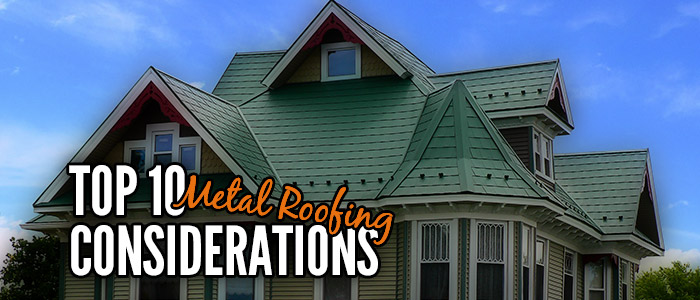Expert Todd Miller’s Top 10 Metal Roofing Considerations
January 2, 2014 | Filed under: Articles, Metal Roofing, Roofing Help, Uncategorized
Does your home need a new roof? Homeowners are increasingly considering metal as an option when re-roofing their homes as well as when building new homes. I have created this list of the “Top Ten Metal Roofing Considerations.”
My Top 10 Metal Roofing Considerations for Homeowners
- What warranties will you receive with your new roof? You should receive warranties both for the product and for the installation workmanship. Make sure that you understand these warranties, know who is providing them, and what the warranty limitations are. Some warranties are much stronger than others in terms of what they cover. Be sure to look at the pro ration and transferability of the warranties.
- Is the product you’ve chosen appropriate for your roof? Various metal roofing materials have certain limitations such as minimum pitch. Even if you have to send photos of your home to the manufacturer, make sure that the product you have chosen is appropriate for your home. Warranty coverage will be lost if not.
- How experienced are the installers? Even the best product, improperly installed, will be a bad situation. Make sure that your installers are experienced with your product and your type of construction. Talk to past customers.
- Do you have low-pitched roofs connected to your metal roof? A different type of roofing material can be required on low pitch roofs. Many of these materials will need to be replaced sooner than your metal roof. Make sure that the junctions between different roofing materials have been designed to allow for easy replacement of the low-pitched roofing.
- How will the penetrations on your roof be flashed? Many roofing materials are heavily dependent upon sealants to seal around chimneys, skylights, vents, and pipes. While sealants will be used on your metal roof, they should not be the sole line of defense against water intrusion. The sealants will not last as long as the metal roof in most cases. Quiz your installer on how things will be flashed to ensure long term performance without sole dependence on sealants.
- Does your roof have areas where debris collects? This could be ice, snow, tree leaves, pine needles, etc. If this is a problem on your roof, there may be special ways to install your roof which help to allow for this collection of debris without damage to your roof. In some cases, the goal is to provide clear paths for debris to exit the roof, or to be cleaned off periodically. Feel free to consult with me or your roofing manufacturer if you have concerns along these lines.
- Do you have attic ventilation needs that should be addressed at the same time that your home is roofed? Proper ventilation will help save summer energy costs and will help avoid an unhealthy and potentially damaging build-up of moisture in your attic. Good ventilation requires both intake and exhaust vents.
- What sort of coating will be on your metal roof? With most metal roofs, the coating provides beauty and protection. A good coating will be fade and chalk resistant and as resistant as possible to streaking and staining. In my experience, the best coatings are those sold under the trade names of Kynar 500® and Hylar 5000® PVDF resin-based finishes.
- What is the condition of your current roof? Many residential metal roofs are ideal for going over existing shingle roofs. There should always be a layer of underlayment installed over the old shingles in these cases. Additionally, any existing leaks or areas of bad decking on your roof must be addressed before the new roof is installed. In most cases, dips and swales in your roof are structural and will still be visible with the new roof.
- Does your roof have flared gables? This is a situation on some home designs by which the ridge (or “peak”) of the roof is wider than the eave (bottom edge) of the roof. This can be a striking design element, but it does not work well with some metal roofing gable end treatments. Make sure that you do not learn this the hard way. If your home has flared gables, make certain that the gable edge treatment being used when your metal roof is installed will not trap water, ice, snow, and other debris.
And, finally, without expanding the list to be eleven considerations, please also know whether your metal roof is quality-certified by the Metal Construction Association. This is a strict quality control program developed by the industry to help ensure quality products in the marketplace.
In most cases, additional information about these subjects can be found elsewhere on www.asktoddmiller.com. And, you’re always welcome to email your questions to me.
Kynar 500® is a registered trademark belonging to Arkema Inc.
Hylar 5000® is a registered trademark belonging to Solvay

Todd Miller has spent his entire career in the metal building products manufacturing industry. He is president of Isaiah Industries, an organization recognized as one of the world’s leading metal roofing manufacturers. Todd is currently Vice President of the MRA (Metal Roofing Association) and a Past Chair of MCA (Metal Construction Association). Through his website, he strives to raise the bar on standards and practices to provide property owners with the best possible products for successful roofing projects.
You may pull quotes from this article provided you include a link back to the original article on this site. You may not reprint this full article, or even a significant amount of the article, without explicit permission. To gain permission, click here.



[…] you think a new metal roof might be in your plan for 2014, check out this article by our company president, Todd Miller, reviewing the Top Ten Considerations when selecting a metal […]
[…] For more information on this subject, look at the entire article from Todd Miller called “Top Ten Metal Roofing Concerns” at www.asktoddmiller.com […]
What happens if you use a lead roof jack with a Decra shingle roof. I’m not interested in warranty issues. I want to know what will actually happen to the roof.
I encourage you to make this inquiry with the folks at Decra. However, my feeling is that nothing horrible will happen. I guess there is risk the steel in contact with the lead may rust over time. Also, the area of the roof downhill from the lead may stay cleaner than the rest of the roof, because the lead ions may kill any biological growth.
I am building a church and I have low sloped roof connect to the metal roof the installer wants to run 2 feet of the TPO under the metal roof. Is there another way
Yours is a great question. Well, yes, the TPO membrane should extend up under the steep roof and even under the underlayment beneath the steep roof. The question revolves around what will have to be done down the road when the TPO needs to be replaced? It should not last as long as the metal roof. And, trying to just butt a new flat membrane up against the metal roof and seal it … well, that won’t work.
This is a situation where horizontally run metal shingles can be your friend compared to vertical panel metal roofs. With metal shingles, you could “open up” the lowest course or two on the metal roof in order to change the low slope membrane.
So, if you want to look at metal shingles, I will be happy to discuss that with you further. (My company is a leading manufacturer of metal shingles and we’re located in Ohio.)
However, if you want a vertical seam metal roof. my suggestion is a fairly wide and strong pitch transition flashing running horizontally on the downhill edge of the metal roof, and extending up under the metal roof. This transition flashing will come out on top of the TPO. You would ideally cleat its downhill edge to hold it down. Anyway, when the TPO needs changed sometime, you will flip up that transition flashing and work in the new membrane (including under the underlayment from the metal roof) and then put the flashing back down.
Please let me know if you have any questions. My email is todd@asktoddmiller.com
Hello…. I’m in the process of buying my first home. It has a metal roof…. but I noticed that there’re leaves on top of the insulation. It looks like the roofers just put wood over the area where a vent use to be. And placed the metal roof over it. I don’t think they put anything between the old shingles & the metal roof. Is this going to be a problem for me later?
Congratulations on your new home. There are many reasons why leaves could be in the attic. They may have been there for years. I would sure though look for any obvious areas where they might be getting in. While it is not my preference, lots of metal roofs are installed direct over old shingles. I would prefer to see a layer of underlayment, and I also interpret the International Building Code as requiring it. That said, many roofs are installed without it and no huge widespread repercussions are know. Is there any chance, though, that you can email me photos of the roof and perhaps the attic as well? I’d be happy to take a closer look at things that way and it might allow me to give better advice. My email is todd@asktoddmiller.com Thank you.
I have a asphalt roof with varying degrees of slopes, angles, and heights and a major problem with pine needles accumulating on the roof. I love my trees, so not getting rid of them and was wondering how well does a metal roof do under these conditions. Will I still have the pine needle accumulation issues and how hard is it to remove the needles?
Generally speaking, debris is a little more prone to slide or blow off of metal than it is off of asphalt shingles. However, in the situation you described, I am sure it will hang around up there eventually. A lot depends upon the shape of your roof. A lot also depends upon the trims your installer uses. You do not want any trims with water channels hidden beneath the roof’s surface as those will clog with debris. Everything has to stay on top of the roof in your case. You also might eventually see the roof get dirty enough that it supports biological growth. It can usually be cleaned if you wish. One good thing is that these things usually do not really damage the metal roof … though if you have an accumulation of debris or dirt that also holds moisture against the paint for extended periods, that could be a problem. I feel you’re in a better place with metal than with shingles but I do not want to “over-sell” you — you likely will still have some issues or may want to clean the roof on occasion. You may be able to use a leaf blower to get rid of things that do accumulate on the metal roof.